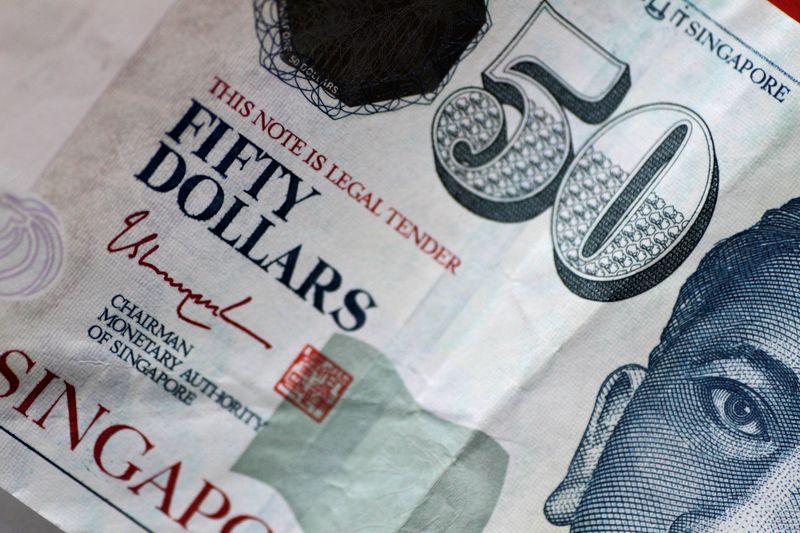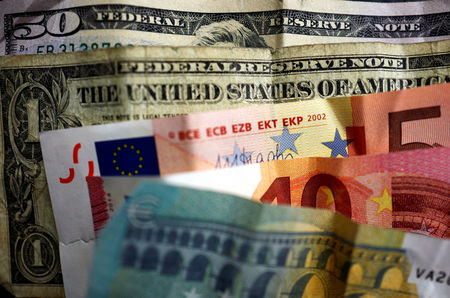
By John Biju and Sameer Manekar
(Reuters) – Investors sharply ramped up their short bets on Asian currencies and turned bearish on the Singapore dollar for the first time since early July on rising concerns that the U.S. President-elect Donald Trump’s policies would erode the attractiveness of risk-sensitive emerging market assets.
Short bets emerged on the Singapore dollar for the first time in four months and were at their highest late June, while those on the South Korean won and the Taiwan dollar scaled six-month highs, a Reuters poll of 10 respondents showed on Thursday.
Trump’s resounding victory in the U.S. presidential elections last week sent shock waves across the emerging markets since his policies of imposing tariffs on Chinese imports are seen fanning inflation which could mean a shallower-than-expected easing cycle in the United States.
The dollar has surged to a one-year high in a matter of days, pressuring the regional assets.
Malaysian ringgit and the Thai baht have lost around 4% since the outcome of U.S. elections became clear last week. Their trade-reliant economies, particularly with China, make them vulnerable to tariff-related headwinds.
“Despite robust domestic fundamentals in strong growth and falling inflation, Asia FX will have to navigate the dual challenge of higher U.S. interest rates and likely higher tariffs by the U.S. in 2025, resulting in a stronger USD,” analysts at ING said.
“Asian currencies with a higher sensitivity to CNY and larger trade surpluses with the U.S. would face the highest depreciation pressure.”
ING analysts said South Korean won stands out on both those counts, and forecast the unit remaining weak throughout next year.
Respondents to the poll had the most unfavourable view of the won, with short bets soaring to their highest since early May.
Bearish bets on the Chinese yuan were at their highest since late June, with analysts expecting Southeast Asia’s largest trading partner to be impacted by sweeping U.S. tariffs.
Chang Wei Liang, FX & credit strategist at DBS, struck a slightly optimistic tone, saying yuan might not emerge as the top loser if tariffs are implemented with the impact manageable at under 1% of its $18 trillion economy.
Views on Singapore dollar turned over the fortnight as its trade-reliant economy faces uncertainty originating from potential global trade headwinds.
“Should tariffs materialise, their impact on ultra-open Singapore is likely to be significant,” Brian Tan, senior regional economist at Barclays (LON:BARC), said.
Tan expects the Monetary Authority of Singapore to ease its exchange rate-based monetary policy next year.
Elsewhere, short bets ratcheted up on the Taiwan dollar, Indian rupee, Philippine peso, and the Indonesian rupiah.
The Asian currency positioning poll is focused on what analysts and fund managers believe are the current market positions in nine Asian emerging market currencies: the Chinese yuan, South Korean won, Singapore dollar, Indonesian rupiah, Taiwan dollar, Indian rupee, Philippine peso, Malaysian ringgit and the Thai baht.
The poll uses estimates of net long or short positions on a scale of minus 3 to plus 3. A score of plus 3 indicates the market is significantly long U.S. dollars.
The figures include positions held through non-deliverable forwards (NDFs).
The survey findings are provided below (positions in U.S. dollar versus each currency):
14-Nov-24 1.14 1.61 0.8 0.81 1.07 0.87 0.65 1.18 0.9
31-Oct-24 0.30 1.06 -0.03 0.59 0.6 0.82 0.11 0.81 0.09
17-Oct-24 -0.43 0.26 -0.44 0.04 0.24 0.67 -0.4 0.26 -0.28
03-Oct-24 -1.14 -0.79 -1.26 -1.08 -0.59 -0.04 -1.18 -0.7 -1.45
19-Sep-24 -0.67 -0.9 -1.12 -1.18 -0.66 0.33 -1.3 -1.1 -1.33
05-Sep-24 -0.85 -1.09 -1.26 -1.05 -0.77 0.21 -1.46 -1 -1.22
22-Aug-24 -0.62 -0.93 -1.08 -1.26 -0.7 0.21 -1.57 -1.03 -1.16
08-Aug-24 -0.02 0.05 -0.61 -0.02 0.59 0.6 -0.78 -0.29 -0.57

25-Jul-24 1.07 0.79 -0.33 0.35 0.86 0.12 0.39 0.43 0.02
11-Jul-24 1.05 0.87 0.06 0.73 0.68 0.22 1.03 0.86 0.51
This post is originally published on INVESTING.




